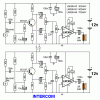jbelectric777
Member
Can someone send me a basic hard wire connected intercom system, I know I need 2 mic's, two 8 ohm speakers but Im lost on the size of resistors and caps, my knowledge only goes as far as : The microphone fills a small cap and triggers a transistor which feeds the 8 ohm speaker via the larger feed current, can ya help me out? Thanks Jim



